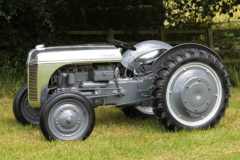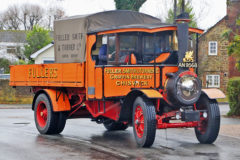Cunard’s Saxonia Class ocean liners
Posted by Chris Graham on 16th February 2022
Daniel Geare charts the history of Cunard’s Saxonia Class ocean liners built for the Canadian service, and their successful cruising careers.

Cunard’s Saxonia Class ocean liners: Sylvania at anchor in the Mersey during the early years of her Cunard Line career, with Liverpool’s famed waterfront behind.
Before the start of World War II, Cunard Line’s Liverpool-Montreal route was operated by six Andiana class liners dating from 1922-25, but none of them returned to service post-war, leaving the Canadian service in the hands of the Scythia class ships, which were originally built for the Liverpool-New York route.
Only one of these ships could reach Montreal, due to the deep draught of the rest of the series, and by 1951 the situation was far from acceptable, so Cunard Line placed an order with John Brown and Co of Clydebank, Glasgow for two new vessels for the Canadian service, each to be powered by four John Brown steam turbines.

Ivernia as she appeared after completion in 1955.
Designed for luxury and speed, they were delivered as Saxonia and Ivernia, with the third and fourth ships, Carinthia and Sylvania, following within of four years. At around 21,600gt and 185m in length, they were the largest Cunarders built for the Canadian service, and could carry 925 passengers over two classes (125 in First and 800 in Tourist), with six cargo holds, which included refrigerated compartments for Canada’s rapidly growing exports.
The ships also featured a shallow draught to allow them to navigate the St Lawrence River beyond Quebec to Montreal, which was important for the success of the service. All four were fitted with air-conditioning and Denny-Brown stabilisers for passenger comfort. As the quartet were built before jet aircraft took over transatlantic travel, Cunard’s Board of Directors believed there would always be a place for liners.
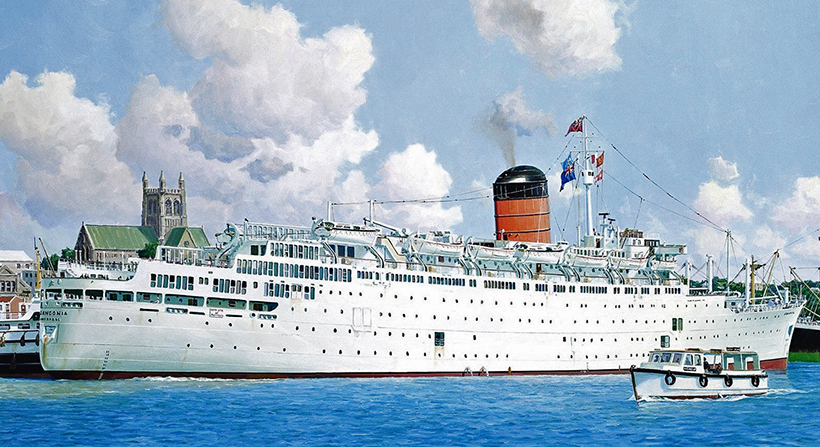
Franconia with a white hull at Hamilton, in Bermuda.
Saxonia was launched on 17 June 1954 by Lady Churchill and arrived in Liverpool for the first time on 23 August 1954. After being opened to the public, she began her maiden voyage to Montreal on 2 September 1954. When returning, she set a record for the fastest eastbound crossing from St Lawrence Pilot Station at Father Point, Quebec to the Mersey Bar Lightship, which took less than five days.
There was a switch to Southampton operations on 19 July 1957, and Saxonia was joined by her sister Ivernia the following year after she had been launched on the Clyde on 14 December 1954, with completion six months later. Her maiden voyage was booked for 26 June 1955, but, due to industrial action at Liverpool, Ivernia departed on 1 July from Greenock, arriving in Montreal six days later with 900 passengers.
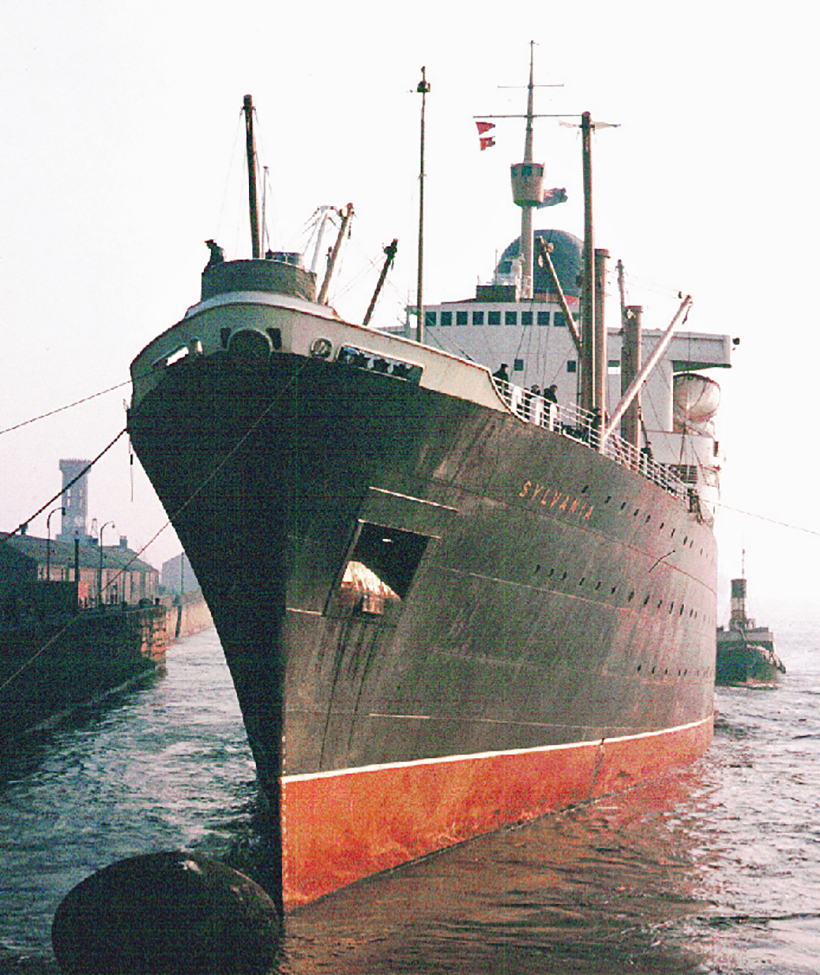
Sylvania docking at Liverpool. (Pic: Albert Novelli)
The introduction of the new liners spelled a bright future for Cunard’s Canadian service, with passenger accommodation on Saxonia and Ivernia tailored more towards Tourist than First class. The pair were the first ships to have a dedicated Tourist Class Head Waiter and had larger, more spacious rooms and amenities compared to liners of the inter-war years.
The third ship, Carinthia, was launched by Princess Margaret on 14 December 1956, and became only the fourth Cunarder to be named by a member of the Royal Family. She was delivered in June 1956 and welcomed members of the public prior to a maiden voyage from Liverpool to Montreal on 26 July.
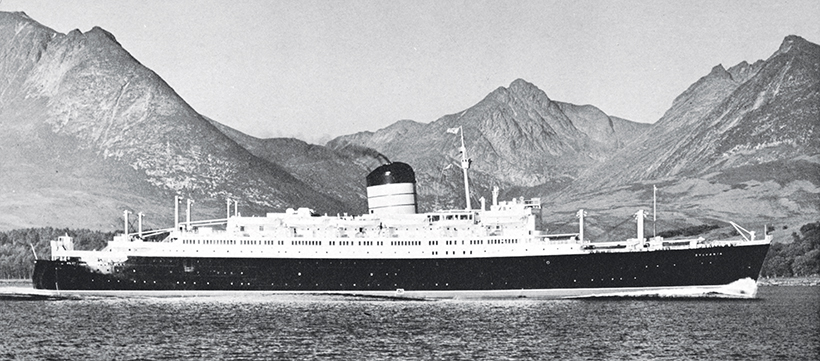
Sylvania is put through her paces off the Isle of Arran on her sea trials.
Last of the quartet was Sylvania, which was launched on 22 November 1956, making her the last Cunarder to be designed exclusively for the North Atlantic trade. She was delivered in early June 1957 and departed Greenock for Montreal on 5 June. She then switched to her intended route from Liverpool on 26 June and, like her elder sisters, moved to the Liverpool-New York route during the winter because of the icing of the St Lawrence River.
Carinthia and Sylvania had more traditional interiors than the previous pair after some passengers expressed a dislike of the modern decor used on Saxonia and Ivernia. However, the four sisters proved to be highly popular on the route and gained the sobriquet ‘brilliant quartet’. But what was the golden age of the Canadian service did not last into the new decade.
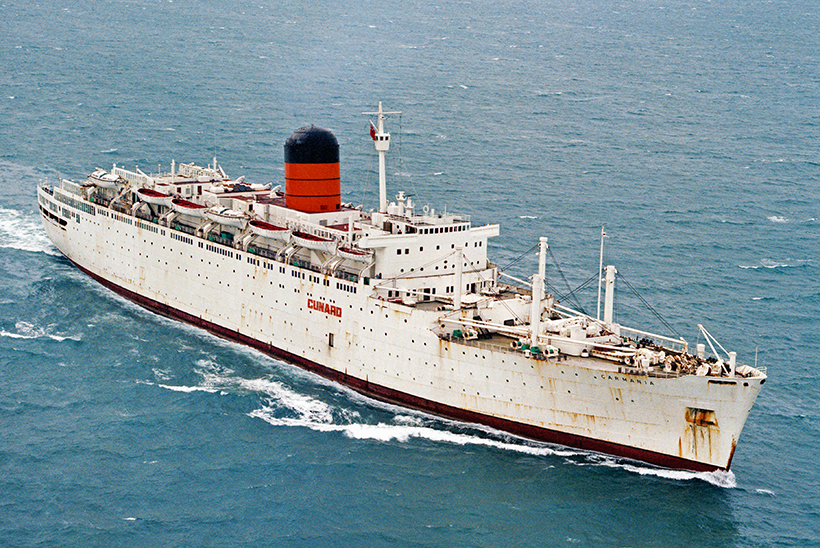
The former Saxonia became Carmania at the beginning of 1963 and, after she had a spell with a green hull, the white Cunard cruise colours appeared from 1967. (Pic: Fotoflite)
As the 1960s opened, passenger numbers started to decline on the route, especially when the ships switched to their winter New York schedules. By 1962 Cunard thought the sisters should have substantial upgrades to help better prepare them for the competition of the jet airliner, but unlike the new ships of the Canadian Pacific, Saxonia and Ivernia were not suitable for cruising. To counter this, they were refitted between 1962 and 1965 with a range of new features, including the addition of private facilities to 60 per cent of the cabins.
These refits were completed by their builders, John Brown, and were deemed so substantial that a name change for the two ships was required. On 1 January 1963 Saxonia became Carmania and Ivernia changed to Franconia. There were major external changes too, including repainting in the green colours of transatlantic liner and cruise vessel Caronia (1948/34,183gt). The decks were extended further aft and the derricks were removed to create space for swimming pools to better suit them to cruising duties and summer transatlantic crossings.
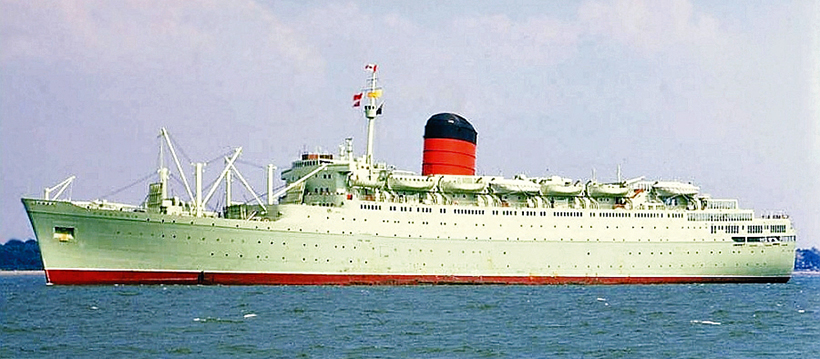
Franconia in the green livery which was first brought in for Caronia.
Inside, the tourist class ballroom ceiling was raised with a new staircase added aft leading up to a grand balcony. The work increased the gross tonnage of Carmania 22,592 and that of Franconia to 22,637.
Cruising white
Despite the green livery being popular on Caronia, it did not work on the smaller ships and, in 1967, both were repainted in cruising white. Post-refit, the pair mainly operated from Southampton on transatlantic crossings and cruises, rarely visiting Liverpool, although Franconia did make two Christmas and New Year 1967-68 cruises from the port.
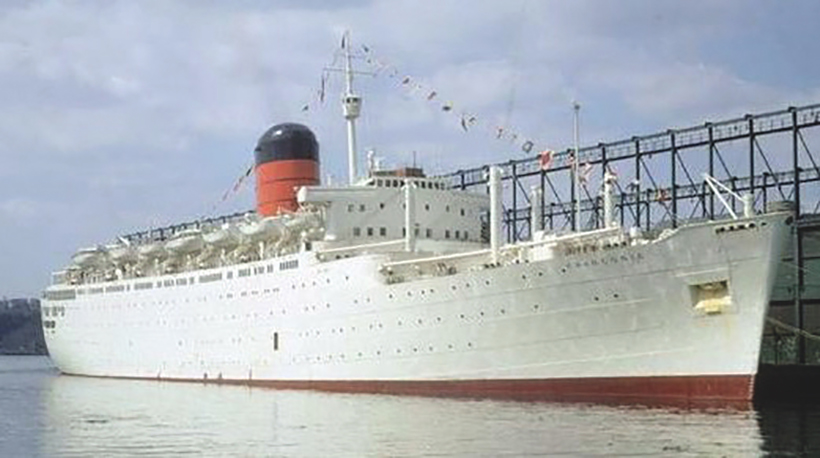
Franconia, with flags flying, during her final Cunard Line years.
Franconia sailed Cunard’s final transatlantic crossing from Liverpool to New York on 30 January 1968, ending a service that had started 128 years earlier with Britannia in 1840. The occasion was played down by the local press, as it was another nail in the coffin for Liverpool as a passenger port. From this point, Carinthia was posted permanently to cruises, while Franconia resumed North Atlantic schedules.
She was switched to run from Southampton in 1968 and, by 1970, Franconia was dedicated to year-round cruising. However, after they began to lose money, the two ships were laid up by Cunard, first in Southampton and then the River Fal, pending sale.
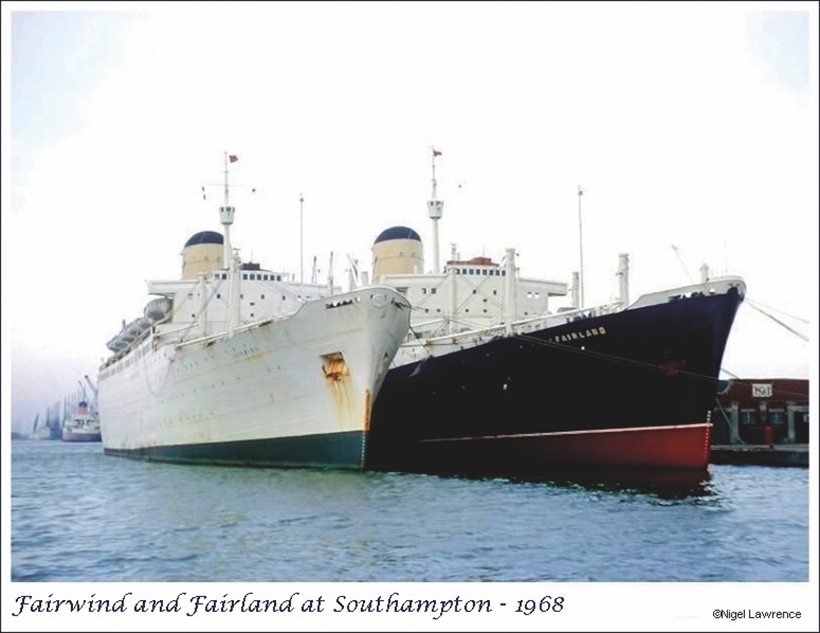
Fairwind and Fairland at Southampton.
The pair were sold to Russian buyers, the Sovtorflot Organisation, via their agent Nikresi Maritime Corporation of Panama. After major three-month refits, Carmania was renamed Lenonid Sobinov, while Franconia became Fedor Shalyapin, but no external alternations were made, so the sisters retained a distinctive Cunard look for the remainder of their careers.
Winter cruising
Unlike their older sisters, Carinthia and Sylvania did not receive major refits or name changes before switching to winter cruising from New York to Bermuda. In October 1967 Carinthia made Cunard’s final Liverpool to Canada sailing, closing a service that played a big part in the post-war growth of Canada. After this, she remained at Southampton until a final sailing from New York in November 1967. She was then laid up and put up for sale, along with Sylvania.
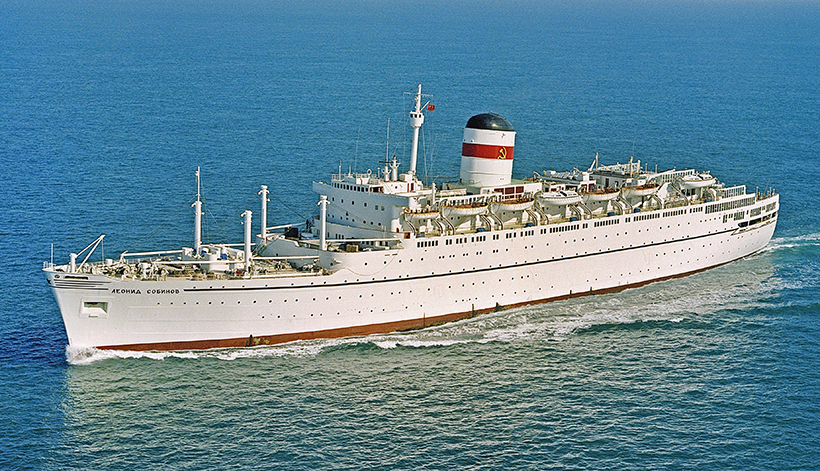
Saxonia in her final years as the Russian-flagged Leonid Sobinov, a name she took from 1973 until a final trip for scrapping at Alang, India, in 1999. (Pic: Fotoflite)
Until this point Sylvania had a regular role on the Liverpool-Canada run before a permanent switch to the Liverpool to New York route in April 1961, replacing the last surviving White Star liner, the diesel-powered Britannic (1929/26,943gt). Unlike Carinthia, Sylvania was refitted in 1965 to make her more suitable for cruising, although the work was not as extensive as that carried out on her two older sisters.
While active on her main route from Southampton to Montreal via Le Havre, she ran aground on a sand bank between Lac St Pierre and Quebec. Tugs spent 24 hours trying to move the ship, after which Cunard offered her 400 passengers a move to Canadian Pacific’s Empress of England, sailing from Montreal at noon the next day. During her 1967 cruising programme Sylvania carried a British Hovercraft Corporation SRN-6 type hovercraft from February to May 1967 as a novel way to transfer passengers to ports of call around the Mediterranean, but it was not a success.
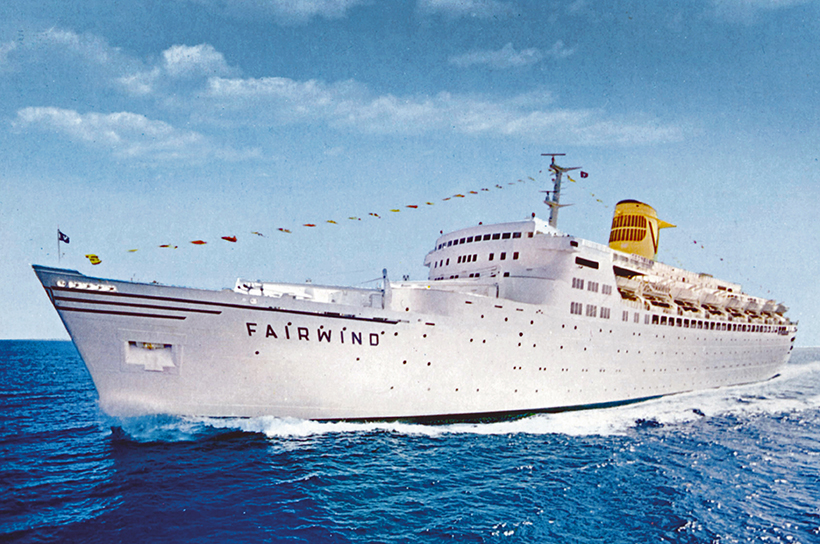
The former Sylvania in Sitmar Cruises ownership, as Fairwind.
Like Carinthia, Sylvania was withdrawn and laid up in Southampton at the end of 1967. They were purchased by Sitmar Line in early February 1968 and renamed Fairwind and Fairland respectively. Originally, the pair were going to be used on Sitmar Line’s immigrant service, but when the contract was lost in 1970 to Chandris Lines, the pair lay at Southampton, until Sitmar decided to convert them for cruising. From January 1970 to January 1971 they were heavily refitted, becoming Fairwind and Fairsea for the North American cruise market.
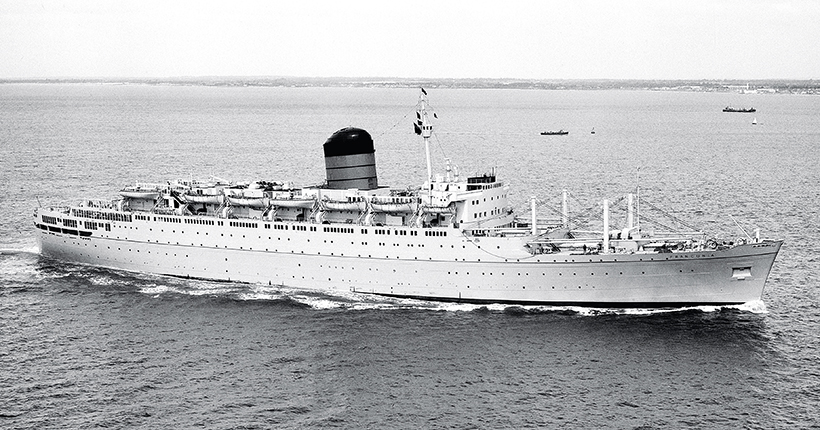
The former Ivernia during her time sailing as Franconia, with a Caronia-style green hull. (Pic: Fotoflite)
Fairwind sailed from Fort Lauderdale to South America during the winter, and to Canada and Alaska from San Francisco in the summer months, while Fairsea was used on the American West Coast. Fairwind was repainted in the new Sitmar Cruises blue-funnelled livery in 1988, but after P&O Group took over in September 1988 they shut down the Sitmar brand and Fairwind was transferred to P&O’s Princess Division as Dawn Princess, while Fairsea was moved, as Fair Princess, to be used in the Pacific.
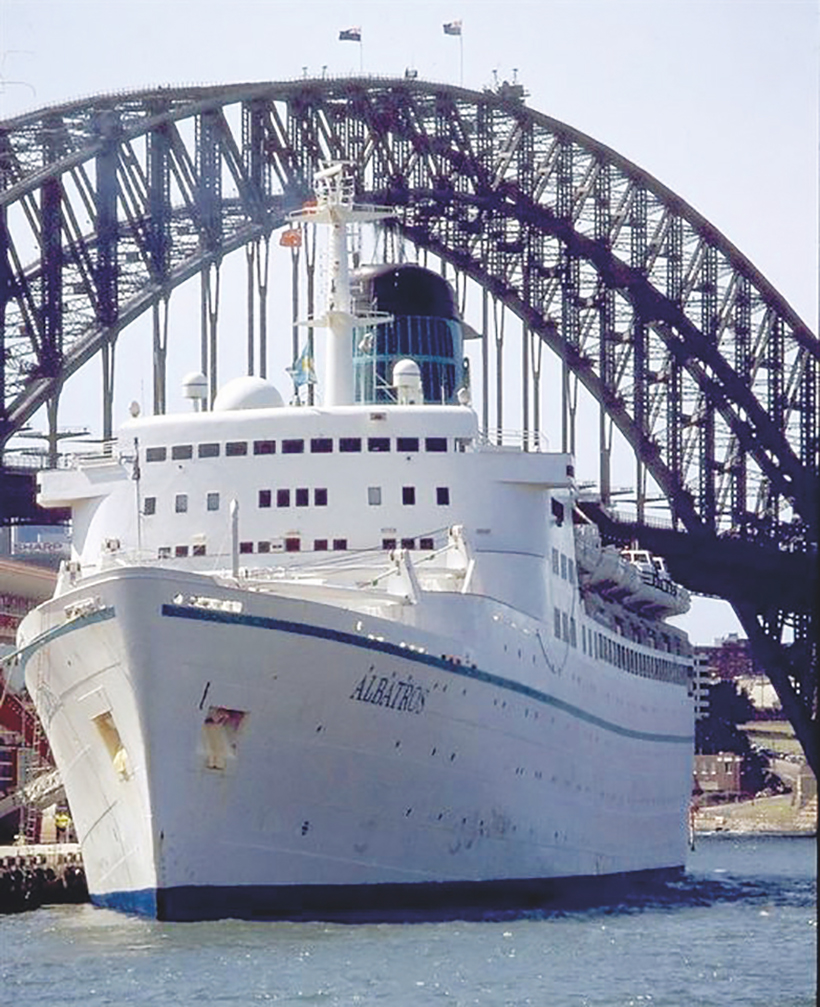
In 1993, Dawn Princess was bought by V Ships and cruised for Phoenix Reisen as Albatros…
During this period, Princess Cruises were investing in new tonnage, which resulted in Dawn Princess being sold to V-ships in 1993 and renamed Albatros to sail for Phoenix Reisen, initially for five years. Her first cruise departed on 18 August in 1993, but she suffered an engine room fire in May 1995 while on a voyage in the Red Sea which required her passengers to be evacuated.
Another incident occurred in May 1997, when she grounded in St Mary’s Sound in the Isles of Scilly and arrived at A&P Shipyard in Southampton on 26 June for repairs before resuming cruises in July. Due to a machinery problem in November 2003, Phoenix Reisen terminated the charter, as repairing her was too expensive, so the vessel went to Alang, as Genoa, in 2004 to be broken up.

… until 2004, when she was scrapped at Alang.
In 1995 Fair Princess was transferred to P&O Holidays (now P&O Cruises Australia) and was chartered to Regency Cruises as Regent Isle, but never sailed before the company went bankrupt in 1995, and she returned to run for P&O.
Final countdown
The former Franconia and Carmania cruised for their new owners until 1995, when strict SOLAS requirements came into force and the sisters were declared surplus to requirements because of the cost of the necessary upgrades. Leonid Sobinov (ex-Carmania) left Odessa on 30 January 1999 under her own power for Alang, India for breaking, only to run out of fuel and drift around the Indian Ocean until two tugs came to the rescue. She was finally dragged ashore for breaking up on 1 October 1999, ending a career of 43 years.
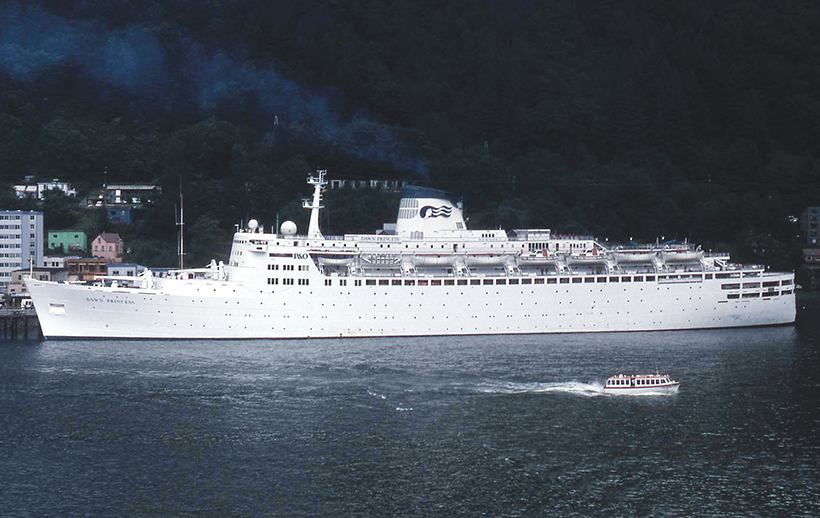
Between 1988 and 1993, Sylvania sailed for P&O as Dawn Princess.
Fedor Shalyapin (ex-Franconia) remained laid up until making a passage to India to be broken up in 2004 next to her old running mate Sylvania, which had been sold to the breakers in December 2003 and arrived the following month.
Carinthia was sold to China Sea Cruises in 2000 for use as a casino ship named China Sea Discovery, but the venture failed. During 2001 she was operated out of Taiwan and, as this was also unsuccessful, she was sent for scrapping at Alang in 2001, where a major fire broke out on board killing a number of workers and injuring many others. Demolition was completed in 2005, after 51 largely successful years for Cunard’s final Canadian liner.
For a money-saving subscription to Ships Monthly magazine, simply click HERE



